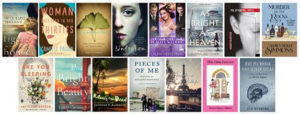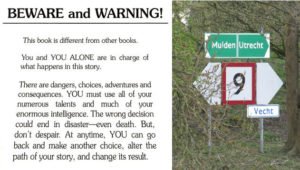My second novel, The Lover’s Portrait: An Art Mystery, is an amateur sleuth mystery describing the plight of homosexuals and Jewish artists in Europe during World War II, as well as the complexities inherent to the restitution of artwork stolen by the Nazis in the 1930s and 1940s.
Before writing it, I read a number of very interesting and somewhat obscure reference books and articles to help me better understand this complex period in European history. I’ve seen several Goodreads threads looking for information about different aspects of WWII and thought this list may help others.
Acknowledgements (The Lover’s Portrait):
All of the books, records and historical documents I used as reference material while writing The Lover’s Portrait can be found at one of these fine intuitions: the library of the Dutch Resistance Museum; the archives of the Stedelijk Museum Amsterdam; the Rijksmuseum’s Research Library and Print Room; the archives of NIOD: Institute for War, Holocaust and Genocide Studies; the Amsterdam City Archives; the National Library of the Netherlands; the Jewish Historical Museum’s library; the Hollandse Stadschowburg: National Holocaust Memorial; the (now disbanded) library of KIT Tropenmuseum; and the University of Amsterdam’s libraries and Special Collections.
Three books were crucial in providing insight into the Dutch art market and standard practices of European art dealers during the 1930s and 1940s: De Nederlandse kunstmarkt 1940-1945 by Jeroen Euwe, Roofkunst – De zaak Goudstikker by Pieter den Hollander and Kunsthandel in Nederland 1940-1945 by Adriaan Venema. Two research papers, written in 1985 by then-bachelor student Rob Lambers, were immensely useful resources in understanding the kinds of exhibitions Dutch museums and galleries presented during the war, as well as how artists’ collectives functioned: Het Stedelijk Museum te Amsterdam tijdens de Tweede Wereldoorlog and Musea en Kunstenaarsverenigingen tijdens de jaren 1940-1945 in Nederland.
The catalogue for the exhibition Westphaalsch-Nederrijnsche Kunst (August 2, 1941 – September 14, 1941) – initiated by Reich Commissioner Arthur Seyss-Inquart, organized by the Nederlandse-Duitse Kultuurgemeenschap and held in the Rijksmuseum – explains why Hitler’s Nazi Regime considered Dutch citizens to be their cultural and linguistic ‘brothers’.
The fictitious Stolen Objects research project and associated restitution process described in this book are based on the actual Herkomst Gezocht (Origins Unknown) project led by the Ekkart Committee. Their reports, published between 1999 and 2004, describe in explicit detail their research into thousands of unclaimed objects still in the care of the Dutch government and their efforts to track down potential claimants through international advertising campaigns and the aforementioned exhibition, Looted, but from whom?. The Ekkart Committee’s reports and findings, as well as a description of the workings of the actual Restitution Committee, are available online in English.
There are countless books written about what Adolf Hitler considered to be degenerate art, as well as his plan to create a new mega-museum in Linz by stealing artwork he admired from private citizens, art dealers and cultural institutions across Europe. I found these four books to be the most useful in understanding Hitler’s motivations and the tactics used to realize his ‘dream’: The Lost Museum: The Nazi Conspiracy to Steal the World’s Greatest Works of Art by Hector Feliciano, The Linz File: Hitler’s Plunder Of Europe’s Art by Charles De Jaeger, Museums and the Holocaust: Law, Principles and Practice by Norman Palmer, and The Rape of Art: The story of Hitler’s Plunder of the Great Masterpieces of Europe by David Roxan and Ken Wanstall.
In contrast, there is very little written about the plight of homosexuals in the Netherlands during World War Two. Luckily I found two books containing a wealth of information which enabled me to better understand the challenges a prominent citizen and closeted homosexual, such as the fictional Arjan van Heemsvliet, would have faced. These two indispensable resources are Het vervolgen van homosexuelen voor, tijdens en na de tweede wereldoorlog (1911-heden), an essay bundle published by the Federation of Dutch Associations for Integration of Homosexuality (COC) in 1985; and the book Doodgeslagen, Doodgezwegen: Vervolging van Homosexuelen door het Nazi-Regime 1933-1945 by Klaus Müller. To give my English readers a better idea of their tone, the titles of these two tomes can be translated as The persecution of homosexuals before, during and after the Second World War (1911-present) and Beaten to Death, Silenced: Persecution of Homosexuals by the Nazi-Regime 1933-1945.
In 1995 the exhibition Rebel, Mijn Hart: Kunstenaars 1940-1945, held in the Nieuwe Kerk in Amsterdam, commemorated Dutch artists who were killed during the Second World War. The exhibition catalogue, written by Sem Dresden and Max Nord, explains how Jewish artists were affected by the rise of National Socialism in the 1930s, the ever-stricter rules created by the Nazi’s Ministry of Culture, and wide-spread censorship. It also includes information about many of these forgotten artists’ work and personal lives. This excellent resource helped me to understand the ordeals my fictitious character, the up-and-coming Jewish artist Lex Wederstein, would have faced.
There is a wide range of literature available which recounts life in the Netherlands, and in particular Amsterdam, during the Second World War. I relied most heavily on three publications when describing the city in war-time: Kroniek van Amsterdam 1940-1945, published in 1948 by the Genootschap Amstelodamum and compiled by J.F.M. den Boer and Mej. S. Duparc; Ooggetuigen van de Tweede Wereldoorlog in meer dan honderd reportages, complied by Connie Kristel and Hinke Piersma; and De bezette stad: Plattegrond van Amsterdam 1940-1945 by Bianca Stigter. The image banks of the Amsterdam City Archives and NIOD were also extremely useful resources when visualizing this era.


Pingback: Restitution of Nazi-looted Artwork after World War Two: A Dutch Perspective – Jennifer S. Alderson